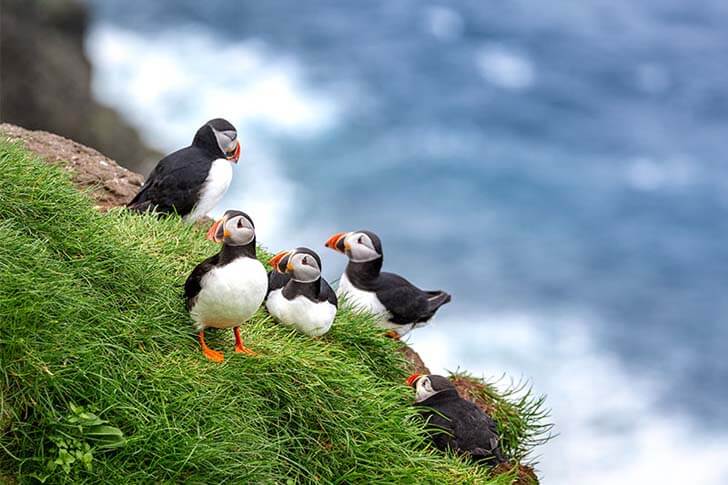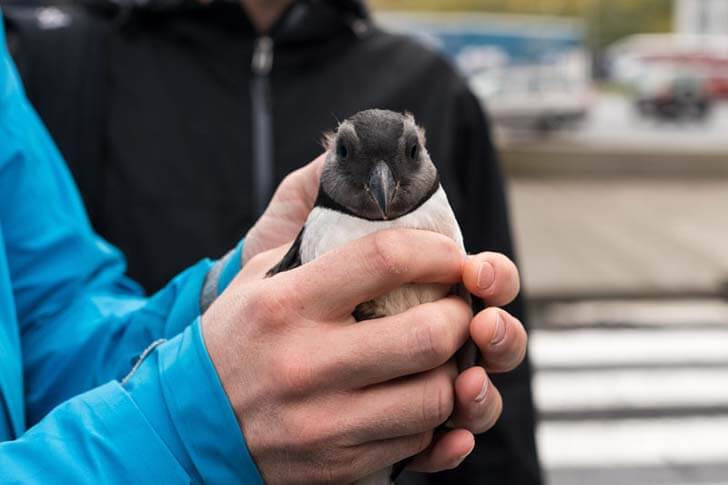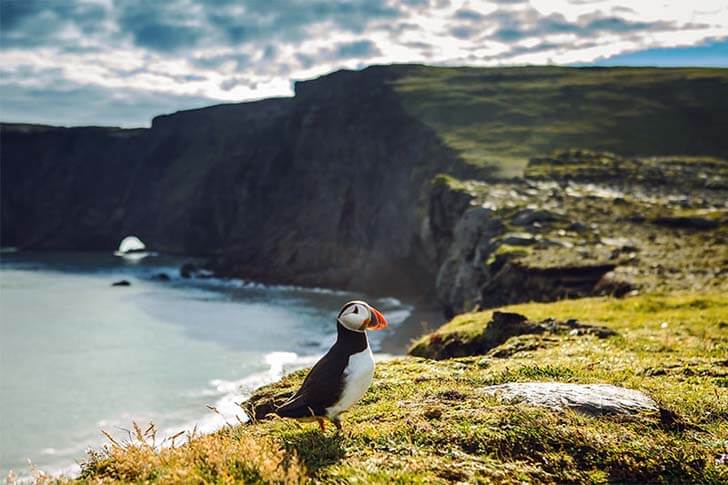HOW
The first step to spotting a puffin is knowing what it looks like. And to help you do that I have provided for you a nice picture of the majestic Atlantic puffin.
It would be rude of me to assume that you are able to spot all the differences between the puffin and any other bird immediately. Therefore I will quickly run you through it‘s most prominent characteristics.
1) The Beak
First things first. The puffin‘s most iconic feature is undeniably its bright and colorful beak. Its colors are especially vivid in the summertime during the bird‘s mating season. In fact, researcher Jamie Dunning recently discovered that the beak of a puffin is actually fluorescent and lights up under UV-lights! Although he doesn‘t quite know the reason for this and is still searching for answers, this is something us Icelanders have known for generations. You see, puffins are extreme raveheads. They spend a large portion of their summers clubbing in Westman Islands completely stealing the show with their awesome, glowing-in-the-dark beaks. So don‘t be surprised when this comes out as the result of Jamie‘s research.

2)The Body
You might notice a puffin‘s coloration is very penguin-like. Combining that with its beak and shape my first assumption was that a puffin simply was the hybrid offspring of a penguin and a parrot. Well, after doing some reading I found out this is not the case and frankly impossible. A puffin is simply the offspring of two other puffins. The reason for their cute bellies being white is the same as for most other sea birds or even marine animals in general. Having a light underside makes you difficult to spot from the ocean deep looking up. Similarily their black backs make it harder for birds of prey to spot them from the sky looking down. Most of the dangers posed to puffins come from below. They have been known to be hunted by seals and even big fish. Predators from the sky include large gulls, skua, and eagles.
3)Behavior
Despite the chubby appearance puffins are rapid. They might require a little run-up before taking off but when they do their top speed of over 90 km/h is enough to warrant a speeding ticket on every single Icelandic road! I can, however, confirm a puffin has never received a such a ticket. Due to their cuteness they usually get away with just a warning. Not only are they fast flyers but excellent swimmers too. When diving they flap their wings just like they would in the sky. It is quite cool and you should look it up on Youtube.
WHERE
Now that you what they look like, the next step is knowing where to look. Well over half of the world’s Atlantic Puffin population fills up Icelandic seacoast and islands in the summer. They choose extremely steep cliffs to dig their burrows in. This means that if you are choosing to observe a colony from the land you will need to be careful in order to avoid falling to your death, which I assume you will not be interested in doing. Remember that unlike puffins you are flightless. Sometimes a single cliff can have too many burrows dug in it, causing it to collapse. This can of course also be caused by inconsiderate humans walking over the nesting areas so make sure you observe from a distance. The main reason for choosing cliffs for their burrows is quick access to the sea. Small Islands are often chosen as this prevents land predators like rats, foxes, and weasels from feasting on the precious puffin eggs. This can be a serious problem and the introduction of rats to a specific nesting island can cause the puffin numbers to drop to almost zero. Many like to imagine polar bears being potential land predators of the puffin. This isn‘t very well documented yet, however one rare interaction between the two species has been caught on tape. Surprisingly it is rather friendly.
The females lay just one egg. Males are involved fathers and the couple take turns incubating the egg and going fishing. The same couple usually returns every summer to their burrow, year after year. This might be for convenience but I‘d rather say its for romance. Puffins are one of only a handful of bird species that do mate for life. Swans, albatrosses, and eagles are amongst the others. After being separated for the winter the couple is quick to pick up where they left off, tidying up their burrow in anticipation for their new puffling.

After hatching, the puffling stays in its burrow for up to 50 days until it is fully fledged and ready to head to the sea for the first time. The puffling does not return to land at all for 2-3 years! The pufflings leave their burrows for the first time at night in order to avoid predation from larger birds. They‘re thought to use the moonlight to navigate. In Westman Islands, an island group in the south of Iceland, a huge chunk of Iceland‘s puffin population nests. The village lights of Heimaey often throw the pufflings off on their journey to the sea, causing them to crash-land in the town streets. This has lead to a heartwarming tradition that has lived for decades. Every year the local children run around town picking up the lost pufflings. They then bring them to the Natural History Museum where they are weighed, measured, and taken care of until they are ready to be released. If you want to get a closeup experience with a puffling visiting them is definitely your best opportunity. The pufflings are usually rescued between August and September. Lots of little puffin lives are saved every year this way.

The Westman Islanders do not only rescue the puffins though. They also hunt and eat them. This is something that has been done, not exclusively in Iceland, for hundreds of years. In the beginning of the 20th-century puffins in Westman Islands were close to being hunted to extinction. A thirty-year hunting ban was put in place and slowly the population grew back. Puffins are still hunted under strict legislation and if you‘re interested you can try puffin meat in various restaurants in Iceland. “Smooth on the palate and gamey, a bit like liver” is how celebrity chef Gordon Ramsay chose to describe puffin meat.
WHEN
Now for the last step. When can you see puffins in Iceland? Puffins only have one reason for stepping foot on land; breeding. They much prefer the sea and spend most of their lives far out at sea, surfing the waves. Due to their tiny relative wing size they can not rest while gliding like most seabirds, forcing them to sleep on the ocean surface. Generally, they arrive to shore in May and leave towards the end of August. Don‘t worry though. Puffins are pretty ugly in their winterkit. Ok, maybe not ugly, but not nearly as they are in the summer The colors of their beaks fade away and their black and white feathers become less distinctive. So you‘re really not missing out.
Back